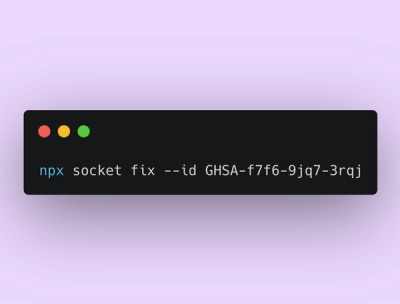
Product
Introducing Custom Pull Request Alert Comment Headers
Socket now lets you customize pull request alert headers, helping security teams share clear guidance right in PRs to speed reviews and reduce back-and-forth.
alpinejs-component
Advanced tools
Reusable HTML components powered by Alpine JS reactivity 🛸
<script
defer
src="https://unpkg.com/alpinejs-component@latest/dist/component.min.js"
></script>
<script defer src="https://unpkg.com/alpinejs@3.x.x/dist/cdn.min.js"></script>
npm install -D alpinejs-component
yarn add -D alpinejs-component
import Alpine from 'alpinejs'
import component from 'alpinejs-component'
Alpine.plugin(component)
Alpine.start()
You can render on page components by using a <template> with an id that
matches the template attribute on the component.
Here we are rendering the component HTML found in <template id="person">
element.
<div
x-data="{
people: [
{ name: 'John', age: '25', skills: ['JavaScript', 'CSS'] },
{ name: 'Jane', age: '30', skills: ['Laravel', 'MySQL', 'jQuery'] }
]
}"
>
<ul>
<template x-for="person in people">
<x-component template="person" x-data="{ item: person }"></x-component>
</template>
</ul>
</div>
<template id="person">
<li>
<h2 x-text="item.name"></h2>
<p x-text="item.age"></p>
<ul>
<template x-for="skill in item.skills">
<li x-text="skill"></li>
</template>
</ul>
</li>
</template>
If you don't want on page components you can use the url attribute which
accepts a path to the HTML component.
Here we are telling Alpine JS to fetch the HTML from /public/person.html
within the codebase.
<div
x-data="{
people: [
{ name: 'John', age: '25', skills: ['JavaScript', 'CSS'] },
{ name: 'Jane', age: '30', skills: ['Laravel', 'MySQL', 'jQuery'] }
]
}"
>
<ul>
<template x-for="person in people">
<x-component
url="/public/person.html"
x-data="{ item: person }"
></x-component>
</template>
</ul>
</div>
Then we'd have a file /public/person.html which could look like this.
<li>
<h2 x-text="item.name"></h2>
<p x-text="item.age"></p>
<ul>
<template x-for="skill in item.skills">
<li x-text="skill"></li>
</template>
</ul>
</li>
You can pass template or url as a dynamic value, here's an example.
<div
x-data="{
components: [
{
template: '/public/person.html',
data: { name: 'John', age: '25', skills: ['JavaScript', 'CSS'] }
},
{
template: '/public/person.html',
data: { name: 'Jane', age: '30', skills: ['Laravel', 'MySQL', 'jQuery'] }
},
]
}"
>
<ul>
<template x-for="component in components">
<x-component
:template="component.template"
x-data="{ item: component.data }"
></x-component>
// Or
<x-component
:url="component.template"
x-data="{ item: component.data }"
></x-component>
</template>
</ul>
</div>
You can use styles attribute to specify which stylesheets to include.
<style title="person">
/* ... */
</style>
<x-component
template="person"
styles="person"
x-data="{ item: person }"
></x-component>
You can also include multiple stylesheets by separating them with a comma.
<style title="person">
/* ... */
</style>
<style title="general">
/* ... */
</style>
<x-component
template="person"
styles="person,general"
x-data="{ item: person }"
></x-component>
Or, if you want to include all stylesheets you can use styles="global"
You can add a <style> element with the components CSS to the component itself.
<div>
<style>
.example {
background: #00f;
}
</style>
<p class="example" x-text="message"> </p>
</div>
If you need to change the name x-component, you can do so by setting the
global xComponent object. This is necessary because blade components start
with x-, which can cause conflicts.
window.xComponent = {
name: 'a-component',
}
You will then call components like this:
<div
x-data="{
people: [
{ name: 'John', age: '25', skills: ['JavaScript', 'CSS'] },
{ name: 'Jane', age: '30', skills: ['Laravel', 'MySQL', 'jQuery'] }
]
}"
>
<ul>
<template x-for="person in people">
<a-component
url="/public/person.html"
x-data="{ item: person }"
></a-component>
</template>
</ul>
</div>



FAQs
Reusable HTML components powered by Alpine JS reactivity 🛸
The npm package alpinejs-component receives a total of 197 weekly downloads. As such, alpinejs-component popularity was classified as not popular.
We found that alpinejs-component demonstrated a healthy version release cadence and project activity because the last version was released less than a year ago. It has 1 open source maintainer collaborating on the project.
Did you know?

Socket for GitHub automatically highlights issues in each pull request and monitors the health of all your open source dependencies. Discover the contents of your packages and block harmful activity before you install or update your dependencies.

Product
Socket now lets you customize pull request alert headers, helping security teams share clear guidance right in PRs to speed reviews and reduce back-and-forth.

Product
Socket's Rust support is moving to Beta: all users can scan Cargo projects and generate SBOMs, including Cargo.toml-only crates, with Rust-aware supply chain checks.

Product
Socket Fix 2.0 brings targeted CVE remediation, smarter upgrade planning, and broader ecosystem support to help developers get to zero alerts.